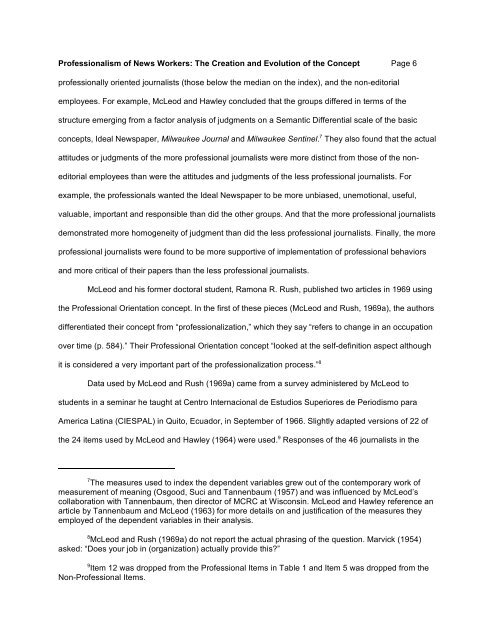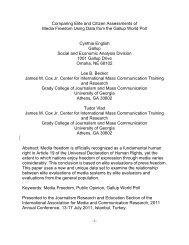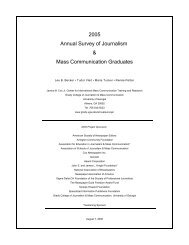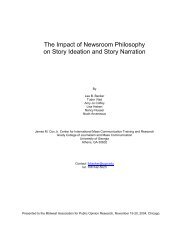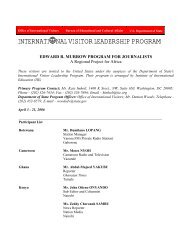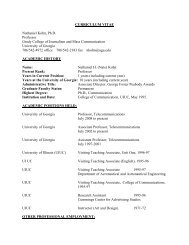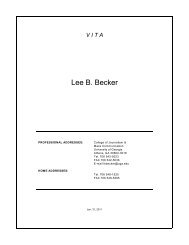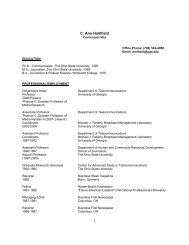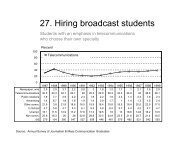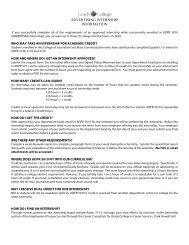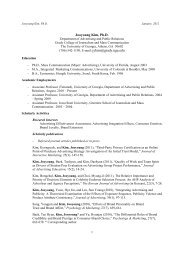Professionalism of News Workers - Grady College of Journalism and ...
Professionalism of News Workers - Grady College of Journalism and ...
Professionalism of News Workers - Grady College of Journalism and ...
Create successful ePaper yourself
Turn your PDF publications into a flip-book with our unique Google optimized e-Paper software.
<strong>Pr<strong>of</strong>essionalism</strong> <strong>of</strong> <strong>News</strong> <strong>Workers</strong>: The Creation <strong>and</strong> Evolution <strong>of</strong> the Concept Page 6<br />
pr<strong>of</strong>essionally oriented journalists (those below the median on the index), <strong>and</strong> the non-editorial<br />
employees. For example, McLeod <strong>and</strong> Hawley concluded that the groups differed in terms <strong>of</strong> the<br />
structure emerging from a factor analysis <strong>of</strong> judgments on a Semantic Differential scale <strong>of</strong> the basic<br />
7<br />
concepts, Ideal <strong>News</strong>paper, Milwaukee Journal <strong>and</strong> Milwaukee Sentinel. They also found that the actual<br />
attitudes or judgments <strong>of</strong> the more pr<strong>of</strong>essional journalists were more distinct from those <strong>of</strong> the noneditorial<br />
employees than were the attitudes <strong>and</strong> judgments <strong>of</strong> the less pr<strong>of</strong>essional journalists. For<br />
example, the pr<strong>of</strong>essionals wanted the Ideal <strong>News</strong>paper to be more unbiased, unemotional, useful,<br />
valuable, important <strong>and</strong> responsible than did the other groups. And that the more pr<strong>of</strong>essional journalists<br />
demonstrated more homogeneity <strong>of</strong> judgment than did the less pr<strong>of</strong>essional journalists. Finally, the more<br />
pr<strong>of</strong>essional journalists were found to be more supportive <strong>of</strong> implementation <strong>of</strong> pr<strong>of</strong>essional behaviors<br />
<strong>and</strong> more critical <strong>of</strong> their papers than the less pr<strong>of</strong>essional journalists.<br />
McLeod <strong>and</strong> his former doctoral student, Ramona R. Rush, published two articles in 1969 using<br />
the Pr<strong>of</strong>essional Orientation concept. In the first <strong>of</strong> these pieces (McLeod <strong>and</strong> Rush, 1969a), the authors<br />
differentiated their concept from “pr<strong>of</strong>essionalization,” which they say “refers to change in an occupation<br />
over time (p. 584).” Their Pr<strong>of</strong>essional Orientation concept “looked at the self-definition aspect although<br />
it is considered a very important part <strong>of</strong> the pr<strong>of</strong>essionalization process.” 8<br />
Data used by McLeod <strong>and</strong> Rush (1969a) came from a survey administered by McLeod to<br />
students in a seminar he taught at Centro Internacional de Estudios Superiores de Periodismo para<br />
America Latina (CIESPAL) in Quito, Ecuador, in September <strong>of</strong> 1966. Slightly adapted versions <strong>of</strong> 22 <strong>of</strong><br />
9<br />
the 24 items used by McLeod <strong>and</strong> Hawley (1964) were used. Responses <strong>of</strong> the 46 journalists in the<br />
7<br />
The measures used to index the dependent variables grew out <strong>of</strong> the contemporary work <strong>of</strong><br />
measurement <strong>of</strong> meaning (Osgood, Suci <strong>and</strong> Tannenbaum (1957) <strong>and</strong> was influenced by McLeod’s<br />
collaboration with Tannenbaum, then director <strong>of</strong> MCRC at Wisconsin. McLeod <strong>and</strong> Hawley reference an<br />
article by Tannenbaum <strong>and</strong> McLeod (1963) for more details on <strong>and</strong> justification <strong>of</strong> the measures they<br />
employed <strong>of</strong> the dependent variables in their analysis.<br />
8<br />
McLeod <strong>and</strong> Rush (1969a) do not report the actual phrasing <strong>of</strong> the question. Marvick (1954)<br />
asked: “Does your job in (organization) actually provide this?”<br />
9<br />
Item 12 was dropped from the Pr<strong>of</strong>essional Items in Table 1 <strong>and</strong> Item 5 was dropped from the<br />
Non-Pr<strong>of</strong>essional Items.


